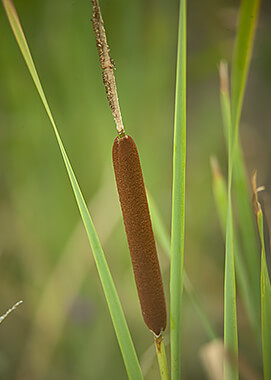Cattail
- Division: Tracheophyta
- Class: Liliopsida (monocotyledons)
- Order: Poales
- Family: Typhaceae
- Genus: Typha
OVERVIEW
It would be hard to find a wetland plant as iconic as the cattail, with its brown, "hot-dog-on-a-stick" flower spikes. Cattails offer more than a scenic backdrop; they create an important wildlife habitat, providing food for small mammals and cover for water birds. Redwing blackbirds, ducks, and geese make nests in dense stands of cattails. These plants help prevent erosion, and they are important in keeping waterways clean and healthy, by filtering out nutrients and contaminants.
CHARACTERISTICS
Deep green, long, narrow, strap-like leaves emerge from the base of the stem and grow upward, but these grass-like plants get their name from their tall, brown flower spikes. Take a close look, and you'll see that a flower spike actually bears separate male and female flowers. The conspicuous brown part is made up of female flowers, and it is topped by a thinner, yellow spire of male flowers. Male flowers bloom first, producing pollen that will fertilize female flowers. In the fall, female flowers explode into white, fuzzy seed-heads.
USES
You may have seen fresh or dried flower arrangements adorned with dried cattails. If you want to try this yourself, be sure to paint the spikes with varnish or clear spray, or you'll eventually be cleaning up a "snow storm" of fluff when the seeds dry! Long cattail leaves can be used to weave mats and chair bottoms, and the starchy rhizomes can be eaten or used to make a flour.

Dwarf Cattail
Native to Europe and Asia, this plant grows to just 18 inches (46 centimeters) tall, making it the smallest of the cattails. It blooms in summer.

Narrowleaf Cattail
In this variety, male and female flowers are separated by a sterile, naked section of the flower spike. It is native to North America and Asia.

Broadleaf Cattail (Common cattail)
Flowering stems can be as tall as 10 feet (3 meters). In this variety, male and female sections of the flower spike are continuous.













